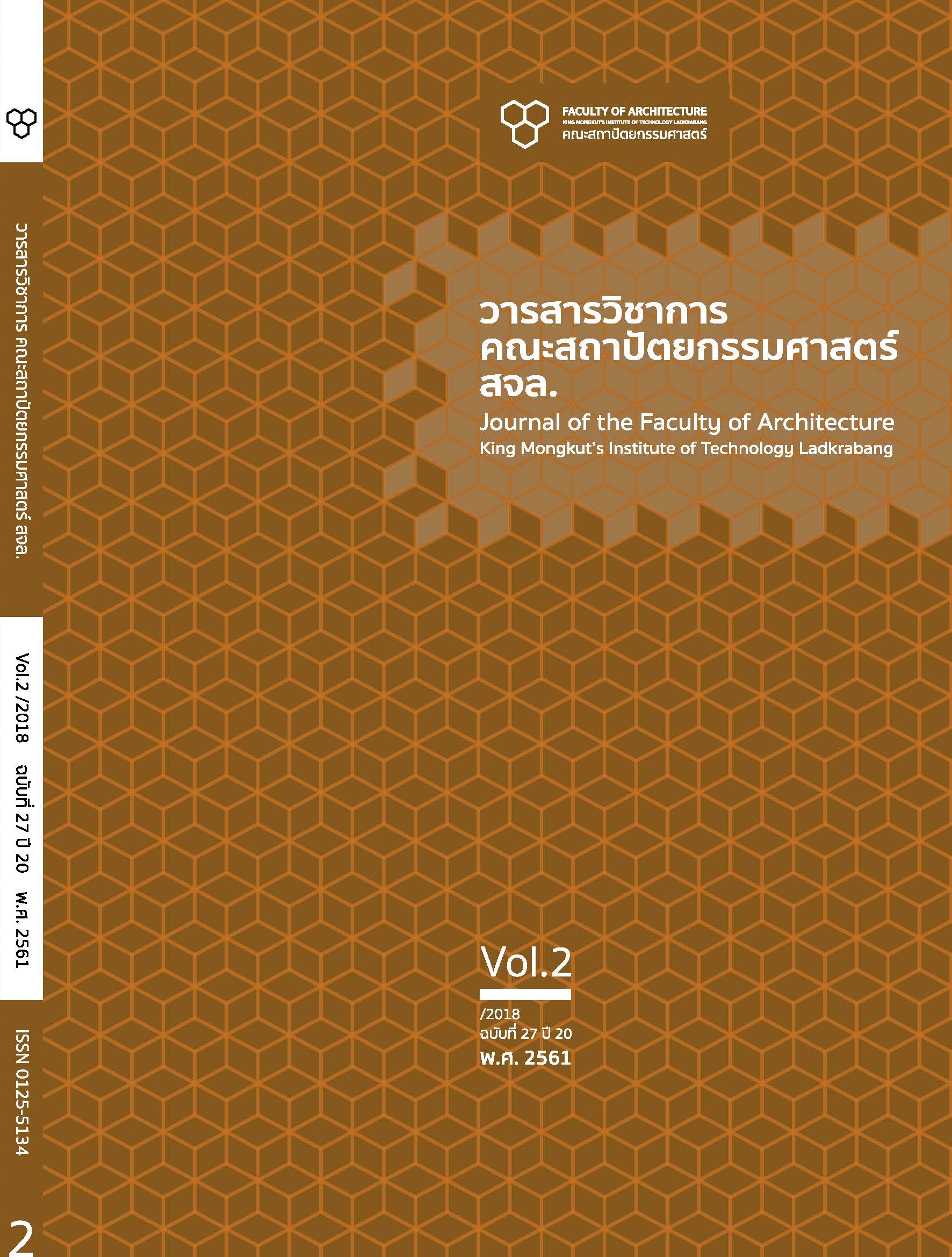การพัฒนาพื้นที่ย่านสถานีแม่น้ำของการรถไฟแห่งประเทศไทยเพื่อการร่วมลงทุนของเอกชน The Development of the State Railway of Thailand’s Maenam Station Area for Public Private Partnership
Main Article Content
Abstract
บทคัดย่อ
งานวิจัยนี้มีวัตถุประสงค์เพื่อศึกษาแนวทางการพัฒนาพื้นที่ย่านสถานีแม่น้ำ ของการรถไฟแห่งประเทศไทยเพื่อให้เอกชนเข้ามาร่วมลงทุน ตามพระราชบัญญัติให้เอกชนร่วมลงทุนในกิจการของรัฐ พ.ศ. 2556 โดยใช้หลักเกณฑ์การศึกษาวิจัยจากกรอบข้อกำหนด พ.ร.บ. ประกอบกับการสืบค้นจัดเก็บข้อมูล เอกสาร การสำรวจพื้นที่ การรับฟังความคิดเห็นของผู้มีส่วนได้ส่วนเสีย การวิเคราะห์ข้อมูลด้านผังเมือง ด้านการคมนาคม ด้านกฎหมาย ด้านสิ่งแวดล้อมวางผัง การใช้ประโยชน์ที่ดินเบื้องต้น การวิเคราะห์ด้านการเงิน และการคาดการผลตอบแทนเบื้องต้น เพื่อหาแนวทางการร่วมทุนและให้การรถไฟฯ ได้รับประโยชน์อย่างเหมาะสม
การพัฒนาพื้นที่โดยการศึกษาวิเคราะห์ข้อมูลอุปสงค์อุปทาน ความเป็นไปได้ทางการตลาด และ สถานภาพธุรกิจอสังหาริมทรัพย์ ประกอบการวางผัง โดยใช้กรอบแนวคิด การพัฒนาแบบยั่งยืน เสริมศักยภาพของพื้นที่ริมน้ำ เพื่อเชื่อมการสัญจรทางบกและทางน้ำ โดยแบ่งพื้นที่เป็น 5 โซน ได้แก่ 1) พื้นที่เพื่อการค้าปลีกการพาณิชยกรรม (Gateway Commercial Park) 2) พื้นที่อาคารสูงเป็นศูนย์ประชุม โรงแรม ศูนย์การค้า และท่าเรือ (Iconic Marina) 3) พื้นที่พาณิชกรรมการค้าปลีก สานักงานและกิจกรรมเชิงวัฒนธรรม (Cultural Promenade) 4) พื้นที่อาคารสูงเพื่อพักอาศัยริมคลองขุด (Riverfront Residence) 5) พื้นที่พักอาศัยระดับกลางสำหรับชุมชนและที่พักสวัสดิการพนักงาน (Affordable Community)
ผลการวิจัยพบว่าแนวทางการพัฒนาพื้นที่ที่เหมาะสมเป็นการวางผังแบบผสมผสาน (Mixed-Use Planning) โดยเสนอการเชื่อมต่อระบบขนส่งทางน้ำ ทางบกและการใช้ระบบรางขนส่งมวลชนแบบเบา (Light-Rail) จากผลการศึกษาโครงการมีความเป็นไปได้สูง ในขณะที่รูปแบบการลงทุนควรเป็นลักษณะที่การรถไฟฯให้สัมปทานเอกชนเช่าพื้นที่ โดยการรถไฟฯ ปราศจากความเสี่ยง และผู้ร่วมลงทุนจะมีระยะเวลาคืนทุนใน 7-9 ปี
คำสำคัญ: พื้นที่ย่านสถานีแม่น้ำ การรถไฟแห่งประเทศไทย พ.ร.บ.ร่วมทุนฯ การวางผังแบบผสมผสาน
Abstract
The objective of this research is to find an appropriate solution for Maenam Station area development, owned by State Railway of Thailand (SRT), and the feasibility for the public private partnership in state undertakings due to the government policy to generate income from state property. The process of research is conducted through analysis of data and document collected, together with site surveying, stakeholder participation, study of laws and regulation, Bangkok Metropolitan land use, conceptual planning and design, initial environmental assessment, economic and project investment return.
Upon studying on demand and supply and real estate scenario for hotel, retail commercial, office, exhibition hall, and residential, together with market sounding process, reviewing current urbandevelopment projects, transportation, mass transit, and initial environmental issues, this research proposes a mixed-use conceptual design schematic for the Maenam Station area development. The scheme suggests 5 mixed-use zones to complement each other, so that the area shall be a major development project of Bangkok. The five zones are 1) a mixed-use gateway commercial park, 2) mixed-use iconic marina, 3) mixed-use cultural promenade, 4) high-rise riverfront residence, and 5) residential affordable community.
The result of research suggests that the mixed-use land use planning with transportation connecting people via Chaophraya River with light-rail mass transit shall be a suitable solution. Regarding the financial aspect, the research suggests that SRT should lease out the property as concession, the project return period
for investor shall be within 7-9 years.
Keywords: Maenam Station Area, State Railway of Thailand, Public Private Partnership, Mixed-use Planning
Article Details
This work is licensed under a Creative Commons Attribution-NonCommercial-ShareAlike 4.0 International License.
Copyright Transfer Statement
The copyright of this article is transferred to Journal of The Faculty of Architecture King Mongkut's Institute of Technology Ladkrabang with effect if and when the article is accepted for publication. The copyright transfer covers the exclusive right to reproduce and distribute the article, including reprints, translations, photographic reproductions, electronic form (offline, online) or any other reproductions of similar nature.
The author warrants that this contribution is original and that he/she has full power to make this grant. The author signs for and accepts responsibility for releasing this material on behalf of any and all co-authors.
References
เข้าถึงได้จาก https://www.ppp.sepo.go.th.
CBRE Thailand. (2559). Bangkok Property Report.
เข้าถึงได้จาก: https://www.cbre.co.th/en/SubServices/Research-Bangkok-Property-Report.
Mallgrave, H.F. and Goodman, D. (2011). An Introduction to Architectural Theory 1968 to the Present. 1st ed.West Sussex: Wiley-Blackwell.
Miles, M.E., Netherton, L.M. and Schmitz, A. (2015). Real Estate Development. 5th ed. Washington D.C.: Urban Land Institute.
Schwanke, D, and Flynn, T. (2003). Mixed-Use Development Handbook. 2nd ed. Washington D.C.: Urban Land Institute.
Steven, R.E. and Sherwood, P.K. (1982). How to Prepare a Feasibility Study. New Jersey: Princeton-Hall.
Russ, T.H. (2009). Site Planning and Design Handbook. 2nd ed. New York: McGraw-Hill.

